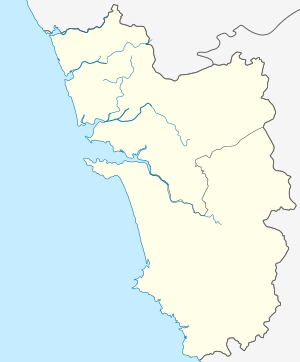St Estevam
| St Estevam Juvem or Jua | |
|---|---|
| Island | |
 St Estevam  St Estevam | |
| Coordinates: 15°31′48.2″N 73°56′28.0″E / 15.530056°N 73.941111°ECoordinates: 15°31′48.2″N 73°56′28.0″E / 15.530056°N 73.941111°E | |
| Country |
|
| State | Goa |
| District | North Goa |
| Taluka | Ilhas |
| Named for | St Estevam Igreja |
| Government | |
| • Type | Panchayat |
| Elevation | 8 m (26 ft) |
| Population | |
| • Total | 4,122 |
| Time zone | IST (UTC+5:30) |
| Postcode | 403107 |
| Telephone Code | 08343 |
St Estevam is an Island in Ilhas, Goa, India. St Estevam is known also 'Juvem' and in the past was known as "Shakecho Juvo" - the isle of vegetables - known for its long, seven-ridged, light green ladyfingers. Therefore the people of Juvem came to be nicknamed ‘bhende’. Juvem is rich in historical heritage and natural beauty.
Conversion to Christianity was started by the Portuguese in the 1550s. The island is named after the Lusonised St. Steven.
Churches
St. Estevam Church
The St. Stephen's Church is also known as St. Estevam Church, which is perched on top of the hillock. The present Church was not the first church on the island. The Jesuits first built the church in 1575, which was destroyed due to fire on 25 November 1683 by Sambhaji Raja Bhonsle during the Maratha campaign against Goa. The villagers of Santo Estevam soon rebuilt their church. However, Maratha forces burned it down again in 1739. The present edifice was erected in 1759.
St. Stephen's Church was one of the large churches to be built in Goa and is special due to its exterior portion resembling a false dome surrounded by twin towers with lanterns. The Church is built in Corinthian style with a nave ceilings decorated with floral graffiti, side altars and elegant pulpit. The main altar of the church is dedicated to St. Stevens. The Statue of St Steven's stands below a four pillared canopy.
The Church contains seven side chapels. One altar is dedicated to Our Lady of Remedios, another to the Crucified Christ. A magnificent altar is dedicated to Nossa Senhora de Boas Venturas, which once served the nearby church of Tolto. The statue of St. Dominic in the Church is believed to have been brought from the convent of St. Dominic in Old Goa.
In the Church compound the villagers put up a monument to Sacred Heart of Jesus which was inaugurated on 16 December 1934 and is popularly known as the statue of Christ the King. It was brought from Rome in 1926 by Fr Antonio Leandro da Rosa. There is another monument to Sacred Heart of Mary blessed on 31 December 1943.
St. Stephen's feast is celebrated on 26 December every Year with great pomp. Saint Stephen known as the Proto martyr of Christianity has his name derived from the Greek Stephen, meaning wreath or crown in Greek.[1]
Notable people
- Angelo da Fonseca, one of India's great artists, was born in St Estevam in 1902. Having studied under Rabindranath Tagore in Kolkata, he was subsequently condemned and expelled from Goa by the Portuguese Colonial Government for his paintings. He had painted the Virgin Mary in a traditional Goan sari. His paintings has been displayed in major cities, worldwide.
See also
References
- http://www.navhindtimes.in/panorama/history-and-heritage-st-estevam-church
- Prof. Prajal Sakhardande
- Dr Olivinho J F Gomes Obituary: http://www.daijiworld.com/news/news_disp.asp?n_id=63406